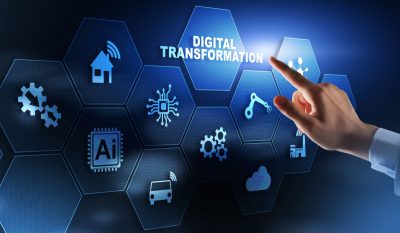The buzzword digital transformation has evolved so much in my growing years, I could only imagine its birth period and its complete turnaround from the 1940s era to now.
Brush with digital transformation
When I was in school two decades ago, the internet was the newest kid on the block. I vividly recall computers being a new phenomenon, and that too, an expensive one. And now, look at the present moment, even a 2-year old has access to a smartphone and laptop. Digital is permeating all our spaces at all times.
For heaven’s sake, what is digital transformation?
The most basic definition of Digital Transformation found on the internet is: “It is the process of using digital technologies to create new—or modify existing—business processes, culture, and customer experiences to meet changing business and market requirements.”
Digital transformation tools comprise third platform technologies and solutions, including cloud, big data, mobile, and the likes. The innovation accelerators—robotics, IoT (internet of things), 3D printing—further fall in the digital realm and help companies, individuals in furthering their revenue goals.
It sometimes surprises me how a lot of companies have now sprung up in the digital transformation services domain to cater to a host of industries. It has actually become another career stream, and that, too, a flourishing one for a lot of individuals.
In the grand scheme of things, a streamlined digital transformation strategy may inevitably help companies navigate the modern headwinds in their favor.
Evolution
Digital transformation has started pervading in all walks of life and all industries. Technically, all processes and systems are computerized now, and all industries operate via digital activities.
When I say all industries, I mean, practically all industries are making use of the digital to get ahead in the game.
Digital is at the pinnacle and center of all activities. You name an industry, and it is working its way up with the digital tools. Starting from health and pharma (it is the most important one right now with Corona wreaking havoc everywhere), telecom, finance, IT, to manufacturing, hospitality, education, tourism, transportation, media and amp; entertainment, food and amp; beverage, energy, retail…you know, I can go on and on!
How are different industries leveraging digital transformation to forward their respective businesses?
Regardless of what industry you belong to, digital is the key word for you, and it is here to stay.
As I see technology marvels all around, I am quite sure that the companies that do not adopt this revolution will be brutally left behind.
For the ease of understanding, I am picking up five major industries that are currently making use of the digital and transforming their revenue conversations like nobody’s business.
Let’s dive right in!
Pharma and healthcare: Smart hospitals and smart systems are the operative words here.
A research document by DTI (Digital Transformation Initiative by Accenture and the World Economic Forum) primarily lists four digital transformation trends: smart care, care anywhere, empowered care, and intelligent healthcare enterprise.
These pretty much summarize the foundation of ‘digital’ in the healthcare domain.
Wearable technology, telehealth remote services, pharma IoT, EHR (electronic health records), AI (artificial intelligence) sensors, and analytics are some of the tools used in all new age healthcare institutions.
Example: Medicalchain, an electronic health record platform powered by a dual blockchain, smart contracts, and cryptocurrency, “MedTokens,” is used to secure patient’s data collected from various sources. It enables patients to own their healthcare data themselves on the blockchain.
Automotive: A seismic change can be observed in the automobile industry since the horse and cart days.
Autonomous driving, mobility as a service (MaaS), connected traveler, digitized ecosystem, virtual showrooms, predictive maintenance, and many such features add value to the production, maintenance, and supply chain of automobiles.
Digitalization also ensures that the car connoisseur gets value for his money with lower insurance premiums and better features. Because, at the end of the day, an automotive company will only thrive when it delivers to its customers—what he wants—at an economical price.
Example: Audi launched virtual showrooms with giant video screens displaying detailed information about the selected vehicle and its buying information. Quite an apt example of the auto company using modern tools to sell its wares.
Banking: The banking, credit union, and fintech domain is gradually waking up to the reality of digital. It understands that consumer acquisition and satisfaction are achievable by taking the digital route.
Digital/online banking, mobile apps, and open banking will capture significant mindshare in the foreseeable future. With COVID-19 already hovering over us, digital and contactless payments opened the floodgates to cope with the new normal. A lot of banks have witnessed a surge in their online counterparts.
A number of banks make use of modern data and analytics platforms supporting the agile deployment of applications, which involve interactive queries, analytics, and machine learning running simultaneously on mutable streaming, transactional, and historical data stored on external data lakes and data warehouses.
Example: In 2019, Bank of America introduced Business Advantage 360, a new digital dashboard to enable entrepreneurs to view and manage the various financial facets of their business.
Information Technology (IT): The IT companies would proudly be able to say that they took the digital-first approach eons ago. Digital and technology blend as water and sugar in lemonade. I will again quote the COVID-19 example here. As the companies world over prepared to work from home in the aftermath of the pandemic, the IT industry was the most prepared to rationally and technologically deal with the challenge.
Cloud computing, cybersecurity, DevOps, unified communication, and data analytics are some of the digital tools that an IT company uses to ensure a world-class user experience apart from ensuring a steady revenue stream.
Example: Deloitte founded a competence center named Deloitte Digital Today and amalgamates all technical, creative, and digital competencies (cybersecurity, optimizing operations, and amplifying brands) to add value to its client portfolio.
E-commerce: The e-commerce sector has possibly grown at the fastest rate. Transforming from brick and mortar stores to online portals stands to be the biggest USP of the retail sector. Tapping the consumer’s choices and giving them what they want is what
e-commerce companies are dedicatedly working toward. More engagements on the web mean more sales in both the present and future.
Usage of tools like AI (artificial intelligence), SEO (search engine optimization), and data analytics keeps most e-commerce companies at the top of their game.
Example: Flipkart introduced the robot-based sortation technology – Automated Guided Vehicles (AGVs) in its Bengaluru, India sortation center. These vehicles help optimize efficiency to meet growing consumer demand, fulfill faster delivery mechanisms, and amazing shopping experience for online consumers.
It’s a wrap
In case you are still mulling over the efficacy of the digital transformation services, let me spell it out for you—Digital is ubiquitous for the modern-day companies. It renders better efficiency, excellent customer experience, makes an employee’s job easier, and above all, ensures profits.
In essence, digital transformation is business transformation.
As established in this article, I just want to conclude by quoting,
“There is no alternative to digital transformation. Visionary companies will carve out new strategic options for themselves — those that don’t adapt, will fail.” — Jeff Bezos, Amazon














